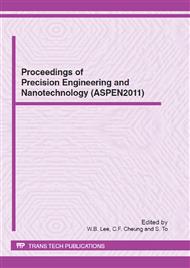p.215
p.222
p.228
p.234
p.240
p.245
p.251
p.257
p.263
Improvement of Grooving Performance of the Dicing Blade by Film Reinforcement
Abstract:
Dicing blades are widely used for cutting brittle materials, such as silicon, ceramics, sapphire and optical glass. In order to reduce the production cost in semi-conductor processing, the substrate of semi-conductor was changed to large diameter. High cutting speed and small loss of material are desired for the dicing processing. To achieve a large safety margin and increase the rate of material utilization, thin dicing blades with fine abrasives are commonly used. The thin dicing blades, however, break down very easily. Thus, it has to be handled with care. In this study, a series of reinforced thin dicing blades with various films were proposed for improving the handling ability and grooving performance. The vibration properties of blades were investigated, too. According to the results, cutting loss and chipping size were reduced by reinforced blades and the higher the damping ratio, the smaller the chipping size.
Info:
Periodical:
Pages:
240-244
Citation:
Online since:
June 2012
Authors:
Price:
Сopyright:
© 2012 Trans Tech Publications Ltd. All Rights Reserved
Share:
Citation:


